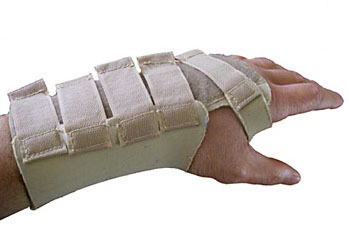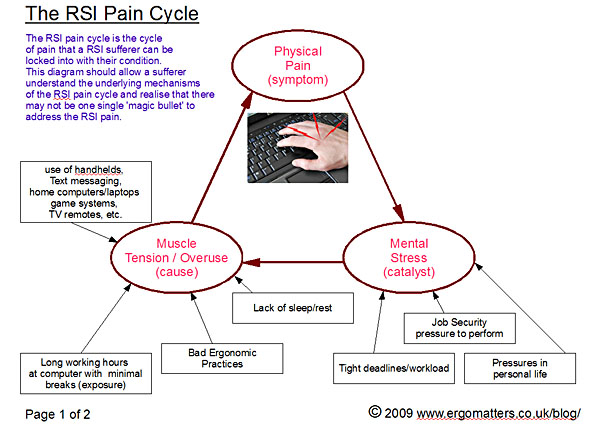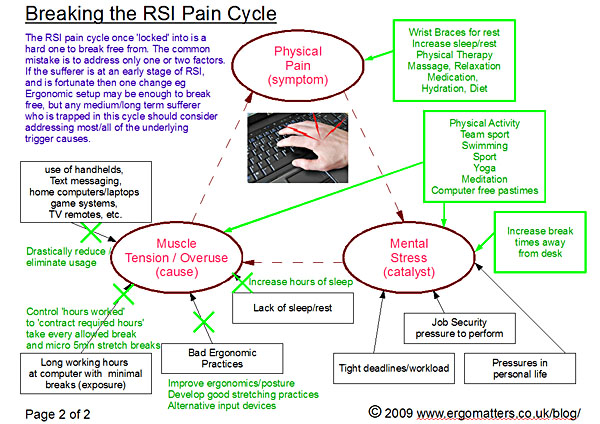 I am happy to announce the release of my latest update to this site, a Repetitive Strain Injury (RSI) Frequently Ask Questions (FAQ) page along with answers! This is basically a download of information from my head as to my understanding of RSI, along with relevant links and information, and is without doubt the largest information release I’ve done on this site. Hopefully you will find this useful. Please feel free to comment and share.
I am happy to announce the release of my latest update to this site, a Repetitive Strain Injury (RSI) Frequently Ask Questions (FAQ) page along with answers! This is basically a download of information from my head as to my understanding of RSI, along with relevant links and information, and is without doubt the largest information release I’ve done on this site. Hopefully you will find this useful. Please feel free to comment and share.
Tag: RSI
Bio Feedback as a tool to combat RSI
Bio Feedback, is a method of measuring an individual’s stresses by monitoring muscle tension, sweat gland behaviour, heart rate etc. It is a non-invasive, non-medical process, designed to raise the awareness of the subject to how their body is reacting to their working environment.
Previously, while living in the US, I was sent for Bio Feedback monitoring, and was ‘hooked up’ to many electrode pads around my neck, shoulders, and arms. These were to be used to measure muscle tension in all the upper body limbs including the neck and shoulder area. The sensors are connected to a computer which plots out the associated muscle tensions on a monitor, so you have real time visualisation of the various muscle tensions you hold in your upper body when operating computer equipment. You are actually seated in front of a real keyboard and mouse, and asked to type and enter data like you normally would in your daily life.
I was actually quite surprised at how much tension the signals showed, and was constantly told to relax the posture to drop the tension levels – not an easy task!
I had to really try to relax my whole body from my head to neck to shoulders to arms to wrist angle to make even the slightest difference. The difficulty was trying to hold it there whilst typing and using a mouse.
Emphasis was placed on relaxing muscles that control the upper limbs, as well as suggestions on how to become more relaxed in the mind both inside and outside of the office environment.
As with other RSI awareness education therapies, there was no magic bullet for me with Bio Feedback, but it certainly helped to raise my awareness of how tense my upper body limbs (including shoulders) became while operating computer equipment, and that really is an important part of the RSI education process.
Rate this post! [ratings]
 I’ve been through a fair share of wrist braces in my time with RSI. Wrist braces are often the first item you will obtain after seeing a physical therapist about an RSI condition. They can be a lot of help to a RSI sufferer, but have to be used correctly, comfortably, and should not be used if they worsen your RSI symptoms.
I’ve been through a fair share of wrist braces in my time with RSI. Wrist braces are often the first item you will obtain after seeing a physical therapist about an RSI condition. They can be a lot of help to a RSI sufferer, but have to be used correctly, comfortably, and should not be used if they worsen your RSI symptoms.
There are a lot of braces out there, and what works for one person may not work for everyone. Braces are usually made out of neoprene or elasticated material coupled with a metal or hard plastic support to immobilise the wrist.
The primary use of the wrist brace should not be forgotten ie to rest wrist joints and forearm muscles that drive the wrist motion (forearm extensors, flexors), and reduce the pain associated from overuse injuries. While this may sound like a good thing, quite often if you wear a brace while using a computer, you will end up using other muscles in a strenuous way to do the same work, and can cause other injuries because of this.
There is no such thing as an ideal wrist brace, it really depends on what they are trying to do.
In the course of your RSI journey you way well encounter many different styles of wrist braces.
My general rules concerning wrist braces are –
- You shouldn’t jump in and buy a wrist brace without first seeking advice from a physiotherapist or doctor.
- Ideally, it should be used to rest (heal) the wrist and the overused (painful) muscles that drive the wrist extension and flexion, and not worn when using a keyboard or mouse.
- Exceptions to the rule are perhaps specific braces intended to stop excessive flexion of the wrist if you are prone to this. It’s a far better idea to be able to spot this flexion yourself and change it, but if you have difficulty doing this then a brace may be required. Alternatively have someone stand and watch over you with a big stick, you will learn faster then!
- Braces used to rest the wrist should not be too tight, just a snug fit. Over tightening can lead to restricted blood flow to the hand and wrists.
- Consider wearing a wrist brace at night in bed to avoid sleeping with your arms/wrists/hands in bent positions. It is critical that you don’t have a tight brace when doing this so as not to restrict blood flow.
- Don’t use them unless you have to. Its better to know your pain, when it happens and try to make adjustments to your work practice etc to reduce the causes than it is to just ‘bandage up’ your injured wrists into a brace.
- Neoprene braces can be hot, sweaty, smelly and itchy to wear even for short periods of time. Better to look for ventilated elastic material ones.
- Wrist braces are not a good universal fit for everyone, so you may have to make some adjustments to it to make it comfortable, including cutting bits out of it or adding some customised padding.
- Wear them at work and they do flag to your employer and colleagues that you have a RSI problem!
Remember though, wrist braces are not a solution to RSI, they are really only there to rest an injury and ease pain. To address your injury it is far better to try to make adjustments to your work to stop the motion that is causing you to have the pain. In other words, you should monitor your wrist, hand motions at a keyboard etc, and make adjustments to your bad working practices, including posture changes. You should also introduce more regular breaks away from your computer along with a good stretching routine and some physical activity.
Rate this post! [ratings]
There is a revealing quote from Dan Odell (Microsoft‘s in-house ergonomist), in an article titled ‘Elementary Ergonomics’ from ‘T.H.E journal.com’ by Jennifer Grayson . He states that –
“There is a growing awareness of how much of an impact there is on students. A lot of the ergonomists I work with at different companies have been noticing that students are graduating from college and coming into the workforce already with chronic repetitive strain-injury problems. It seems at least from the anecdotal stuff that it’s important to start focusing more on the student population.”
This could unfortunately be the start of the RSI epidemic wave that I have long been expecting. The younger generation coming through universities and colleges of further education are the ones that have been exposed to ‘technology’ since they were born and have grown up accustomed to a hi-tech life full of computers, mobile phones, gaming systems and other ‘daily use’ gadgets in complete ignorance of the danger that they pose. They are the generation that have grown up with an ever expanding level of text messaging.
What this generation does not appreciate are the dangers associated with RSI type conditions and their implications for future employment (and earnings) prospects. I also wonder whether employers realise the risks of employing people with these conditions, especially into computer intensive jobs. It may not be too far in the future before employers start to check for these conditions during a pre hiring medical examination, although it may be hard to diagnose without honesty from the potential employee.
What is obvious to me is that ergonomic and RSI health awareness training currently aimed solely at employed adults has to be brought into schools, colleges and universities also to educate the future employees before they succumb to a debilitating RSI condition when they start their employed adult life.
Rate this post! [ratings]
Breaking the RSI Pain Cycle
 The RSI pain cycle is the cycle of pain that a RSI sufferer can be locked into with their condition. The first diagram on the right (click image to enlarge) should allow a sufferer to understand the underlying mechanisms of the RSI pain cycle and realise that there may not be one single ‘magic bullet’ to address the RSI pain.
The RSI pain cycle is the cycle of pain that a RSI sufferer can be locked into with their condition. The first diagram on the right (click image to enlarge) should allow a sufferer to understand the underlying mechanisms of the RSI pain cycle and realise that there may not be one single ‘magic bullet’ to address the RSI pain.
The RSI pain cycle once ‘locked’ into is a hard one to break free from. The common mistake is to address only one or two factors. If the sufferer is at an early stage of RSI, and is fortunate then one change eg ergonomic setup may be enough to break free, but any medium/long term sufferer who is trapped in this cycle should consider addressing most/all of the underlying trigger causes to allow the transition to an RSI free life. The second diagram (click image to enlarge) shows the key areas to address to break the cycle.
You can also download the 2 diagrams in Breaking The RSI Pain Cycle (pdf)
Rate this post! [ratings]
Trigger Finger and RSI?
I’ve just been dealing with a bad case of trigger finger – a condition where a finger becomes locked in a gripped position.
It’s happening (quite badly) on the middle finger of my right hand – so much so that I have to use my other hand to prise the stuck finger open again! I also have minor trigger symptoms on some of my other fingers. It’s not just an inconvenient condition, it can be quite painful too! Usually trigger finger cases can clear up with some rest, ice and anti-inflammatory medication but this one has been with me for quite some time.
The trigger condition has been diagnosed as such by doctors, and has been treated twice with steroidal injections (to no avail). Surgery looks like the next option for me to relieve this condition, and is only a day patient procedure done under
 Below, I provide a list of criteria that I would associate with a worker who will have an elevated risk of contracting an RSI condition. If you associate with a few of these activities, then you too may be at high risk of developing a RSI condition –
Below, I provide a list of criteria that I would associate with a worker who will have an elevated risk of contracting an RSI condition. If you associate with a few of these activities, then you too may be at high risk of developing a RSI condition –
- Computer operator professional or otherwise
- Deep in concentration about your work, intolerant of interruptions
- You slouch at your desk, peering at the computer screen, unaware of your posture
- Working on a key project with tight deadline
- Stressing about achieving that deadline
- Working in a competitive environment in uncertain times
- Spending your work time at a computer for 5-10 hours a day
- Taking minimal breaks, and most of these are spent checking email /surfing the web
- Lunch is frequently a sandwich eaten at your desk whilst working
- You are a heavy coffee drinker
- You spend a cumulative 30 min/day sending text messages on your mobile phone
- You go home after a 10 hour day and relax by ripping some CDs to mp3, updating your iPod, catching up on personal email and unwinding by playing a ‘shoot ’em up’ on your computer/games system for 2-3 hours
- You spends 6-8 hours sleeping before starting the cycle again
Lets break down each point and try to inject some solutions –
Video Games and RSI
 An interesting article appeared in the Times Online titled “Doctors identify ‘PlayStation palm’ as a legitimate medical complaint” which takes a broad look at how more and more types of repetitive strain injuries originating from use of video gaming machines are being discovered. It should be noted that a ‘video gaming machine’ can encompass the set-top box variety, a full-sized PC or indeed a miniature hand held device, the only difference being the types of repetitive motion that the users engage in order to interact.
An interesting article appeared in the Times Online titled “Doctors identify ‘PlayStation palm’ as a legitimate medical complaint” which takes a broad look at how more and more types of repetitive strain injuries originating from use of video gaming machines are being discovered. It should be noted that a ‘video gaming machine’ can encompass the set-top box variety, a full-sized PC or indeed a miniature hand held device, the only difference being the types of repetitive motion that the users engage in order to interact.
It should also be noted that video gaming is a highly addictive pastime (I speak from the experience of my youth). Video games are designed to be addictive; let’s face it, if they were not, players would rapidly lose interest and move onto something else, and the manufacturers would not sell many games.
There are usually very high levels of
Addicted to Technology
 We are a species that spends most of our lives battling addictions of one sort or another – ranging from what we consume to television to news, the list is endless. Our addiction to technology is no different. The cool technological gadgets that adorn our lives are just so addictive!
We are a species that spends most of our lives battling addictions of one sort or another – ranging from what we consume to television to news, the list is endless. Our addiction to technology is no different. The cool technological gadgets that adorn our lives are just so addictive!
There are so many ways today to fritter away huge amounts of our time in our new virtual worlds. Have you ever played a video game and noticed how 3 hours of your life just disappeared?
Technology has brought us immense benefits as a society, but it has also made us slaves to a great extent, and we spend ever increasing amounts of time interacting with devices whether they be computers, mobile phones, PDAs, games consoles, MP3 players, GPS or TV remotes.
A substantial portion of employment now involves working on computers, whether it be the inputting/analysing of data, or the creation of the latest software that controls our lives. The trouble is that, the more high technology we introduce to our lives, the more time we spend interacting with it, often to the disadvantage of our health. It’s not too hard to imagine that, if current trends continue, there will be a technological gadget to interact with from the moment we wake up until the moment we fall asleep (or more scarily from the moment we are born until the moment we die!).
The Web has expanded the information available at our fingertips by a staggering amount. It has also changed
RSI – Mouse use biting people
An excellent RSI article has appeared on BBC News technology section title “The mouse is biting some PC users“. The article quite concisely summarises the main issues at hand (no pun intended) with RSI.
The article indicates that RSI is part of an ever increasing phenomena affecting 115,000 workers last year a staggering 34% increase from the previous year. If ever we needed evidence that RSI is reaching epidemic levels, then this is it.
It also contains a quote from Pauline Cole (a spokesperson for the Association of Chartered Physiotherapists in Occupational Health and Ergonomics (ACPOHE))
“A lot of people are using computers more, even in jobs you wouldn’t traditionally expect it”.
This is the trouble with RSI conditions. Just about every job these days requires interaction with computers, and this can present major challenges when a worker is affected with RSI, there are few options out there to allow them to work whilst avoiding computer use and allowing their bodies to recover, except for perhaps manual labour.
In another revealing quote from the article, this time from Bunny Martin (who runs charity Body Action Campaign)
“schools tend to have a single standard computer set-up for nine and 15-year-olds alike.”, and alarmingly she notes that “around 60% of children she meets have first symptoms of RSI, including strain-related pain in the neck and shoulders.”
This is a staggering fact and if RSI is impacting children years before they start looking for employment then we truly are sitting on a RSI health time bomb.
All in all an excellent summary article on where we are at with RSI.
Rate this post! [ratings]